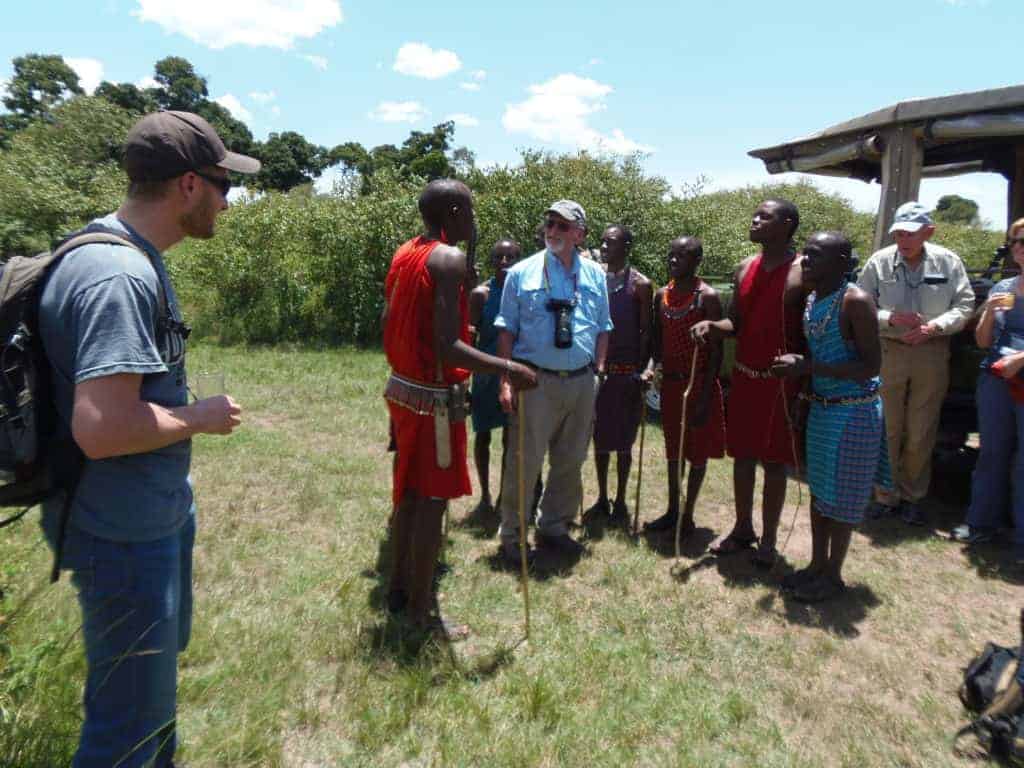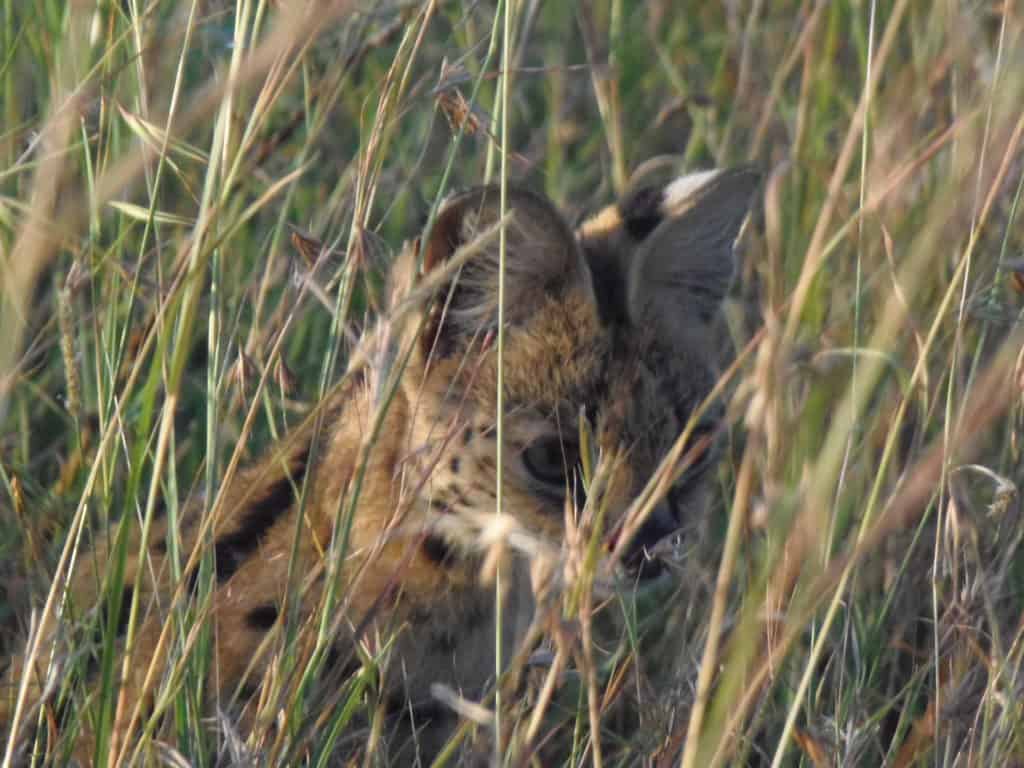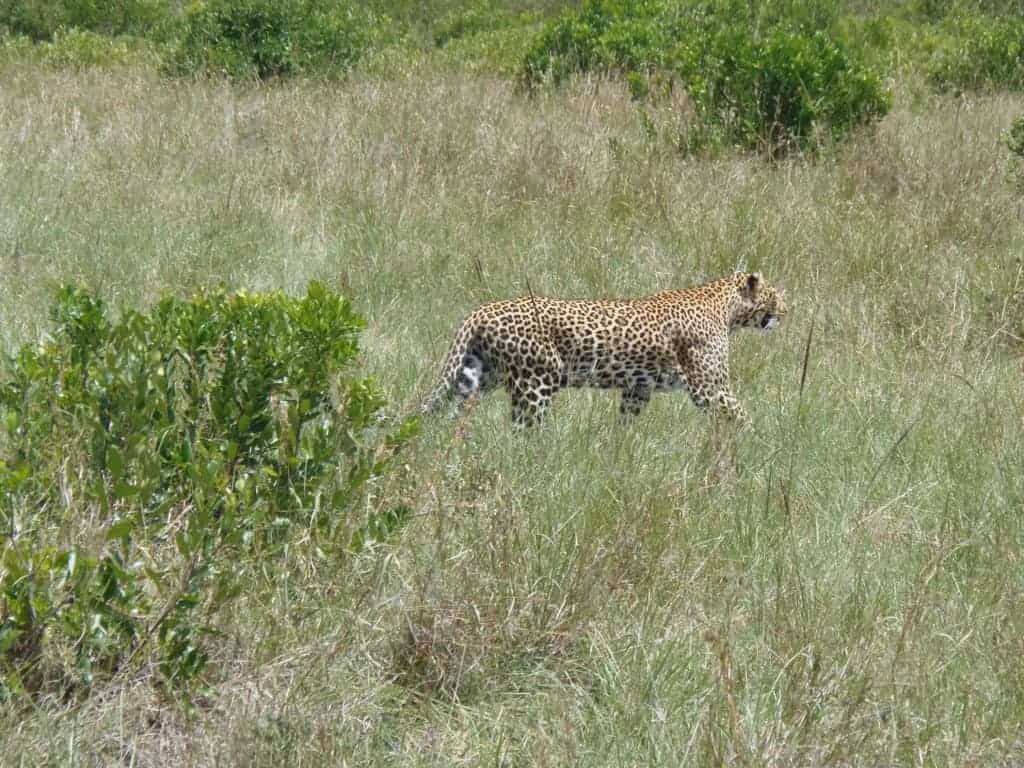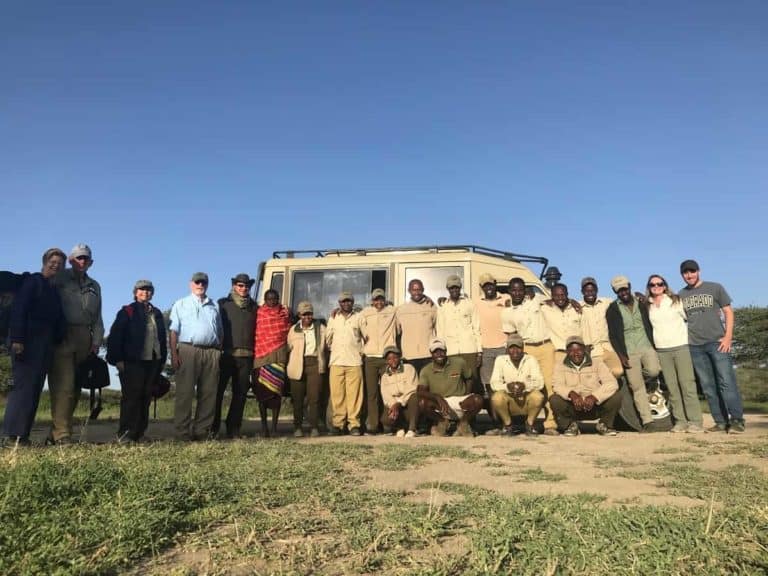Nearly at camp now, we say hello to a resident lioness of the Backyard Pride who is relaxing on the sand – so named by the biologists at Njozi Camp because the pride literally lives in the “backyard” of camp.
We arrive slightly past our dinner time thanks to all the action on the way, but the camp staff are eager to meet us with cool damp towels and a refreshing welcome drink in the lounge area of the main tent. The camp manager Joe gives us a warm welcome and we all happily enjoy a shower, a hearty meal and our first night of trading stories with the camp’s resident wildlife biologists, Yusuf and David, by the campfire under the African stars.
The next morning, we head out with Deo and Sosy before sunrise with picnic breakfast and lunch boxes, and are delighted to find a female cheetah before we even leave the “backyard.” We learn that she is Sugar, a cheetah the biologists have been studying, and she has a new set of cubs that we hope she might lead us to, but she does not. We stay awhile as Sugar basks regally in the early morning light, her beautiful red-orange eyes scanning the horizon, stretching and cleaning herself, before we leave her at peace so she can tend to her cubs.
Ready for some cub action, we make our way to the marsh area to visit the Marsh Pride, where Sosy correctly anticipates two mother lions will be sunning their cubs – eight cubs in total. We are delighted to sit back and watch as the little balls of fur finish up a meal with their moms, then tumble and run down to the water for a drink – Mom gets a sip too. Individual personalities are on full display as the mothers move the pack of cubs to another area, the cubs navigate a small but intimidating stream crossing, and eventually settle into a wooded area to rest. Sharing an hour with this pride is an adorable and entertaining way to spend the morning, and while we could watch their cute antics all day, more and more vehicles show up and we decide to move on and relieve some of the pressure on these lions.
Eventually, the cheetah brothers begin walking with purpose and calling out, moving from tree to tree and picking up on the scent of a female in oestrus. Their calls become more urgent and by the late afternoon, Coffee and Milk have suddenly split off and gone a bit “haywire.” They each go opposite directions suddenly and begin making more urgent, repeated calls, alternating between a high-pitched call and a low, guttural mating call. It is highly unusual for the coalition to split like this, especially at the distance they are now apart from each other. We follow one male as he ramps up his desperate search for the female – cheetahs are highly endangered, and it is extremely important that one of the males finds her while she is in heat and they can mate.
As he searches, a herd of wildebeest moves in and Deo spots a calf that has quite literally just been born – the afterbirth is still visible hanging from the mother. The speed at which everything happens next is indescribable, and the energy feels frantic as we watch the male cheetah spot the calf and the herd begins to run at full speed. The young calf, not more than 20 minutes old, is learning to run for the very first time as it is chased by a cheetah. A brave herd of zebra moves in to block the hunt and the cheetah gives up what was a half-hearted attempt anyway as he is singularly focused on mating at this point. The young wildebeest has survived its first 20 minutes of life in the Serengeti, just barely.
We follow the cheetah as he even climbs a tree at one point for a better vantage point and calls urgently for the female. We wish we could follow him all night, but it is nearly dark and we head back for another wonderful evening at Njozi, giddily sharing stories of our day with David and Yusuf who have been out doing their own field research all day.
The next morning, we are joined by the wildlife biologists for a special day of game driving among the Ndutu wildlife that they know so well. For the first half of the day, we are with David, who shows us how the biologists record identifying features on individual lions and cheetahs. We visit the Marsh Pride again, but the cubs are hidden away in the bushes this time– we can see the bushes shake and hear the cubs’ tiny snarls at each other as they play and wrestle. A pair of lions mates, but David explains the female is actually bluff mating and not really in oestrus as she is already apparently pregnant Bluff mating is nothing unusual for this lioness, and is one way to keep the males of the pride happy and the dynamics stable, as the father of the cubs she is carrying is likely from the Backyard pride, not this Marsh pride—information that we benefit from by traveling with resident biologists and guides who know the big cats intimately.
David shares additional history on the four lions around us and their pride dynamics, adding so much meaning to the wildlife interactions we are witnessing. We head out to the plains of the Serengeti once more to look for Coffee and Milk, hoping one has found the female to mate, but we do not encounter them again. After a delightfully gourmet bush breakfast that the guides have set up, we head down to another marshy area and David spots a solo female cheetah in the grass. We watch her patiently as eventually a herd of wildebeest funnels down into the area. Our cheetah girl is on the move, stealthily walking toward them when suddenly she notices a group of two lionesses and a male lion up on a hill – she has spotted them with her incredible vision, and though she lowers herself carefully into the grass, she knows they have seen her too. Lions will steal a kill from a cheetah and end its life in the process, so she must be incredibly careful if she makes a move to hunt.
We stay with her for upwards of another hour; she rests and lies low for quite some time before deciding that she is hungry enough to risk a hunt. She purposefully stalks through the grass and finds perfect cover in the taller areas of the marsh as she gets to within 50 yards or so of the herd without being spotted. We watch with indescribable anticipation and our breaths held – suddenly, she rises up from the grass and explodes into a full chase. My heart pounds at the display of exquisite beauty and raw power that is a cheetah running at full speed. The wildebeest move in a chaotic flurry; she has picked a calf from the herd and expertly takes it down in the small stream nearby. As the young calf takes its last breath, I am both sad for the wildebeest mother who has lost her young, yet happy for this cheetah who desperately needed food. Such is the way of life in the Serengeti.
She is keeping an extremely close eye on the lions, who luckily have not moved at this point, but are keenly watching her as she brings down her kill. She is incredibly stressed out and anxious about her kill potentially being stolen, and she pants and lies still for a long time. We wait to see if she will eat, but she is far too anxious about the nearby lions. The lions begin to move, but thankfully for her, it is toward another herd of wildebeest that have now moved into the lions’ area. We watch as the two lionesses make an unsuccessful attempt to hunt, but our view of the major action is blocked by the hill as we try to follow at a safe distance in order to not interrupt their hunt.
This afternoon, we set out with Sosy and Yusuf toward the far reaches of the southern Ndutu/Serengeti area as we seek out a pack of wild dogs seen recently in the area – a long shot to find them, but we must try. It is a long and beautiful drive across the plains, and we come across lions, wart hogs, kori bustard, secretary birds, zebras taking dust baths, and Yusuf even spots an elusive honey badger darting across the grass before it dives back into its burrow. We stop for a fascinating and hilarious look at dung beetles, rolling their dung balls and fighting on top of them for dominance as they hope to woo females, and an insightful reminder from Sosy about the deep importance these little beetles hold as the janitors of the Serengeti.
As we drive further south, we are reminded of the meaning of Serengeti in the Maa langauge – “endless plains.” The plains are impossibly vast, and we see the largest, densest concentration of wildebeest, zebra and gazelle yet – it seems like an animal per square foot, as far as the eye can see. The herds go on and on, the entire vista teeming with herbivores. We search for the wild dogs until we must leave in time for sunset. They have eluded us this time, but the trip down south is an exciting and scenic conclusion to our game drives in the Ndutu region.
We are surprised with a delicious traditional Swahili dinner back at camp and a special musical performance and dance. Sosy and David play the drums, Yusuf and Viana sing, and the entire amazing staff – as well as us – sing, clap and dance along. It is one of the most memorable experiences of my life and we say bittersweet goodbyes the next morning to Njozi, to Tanzania, and to Deo and Sosy, with heavy hearts – until next time.






























































